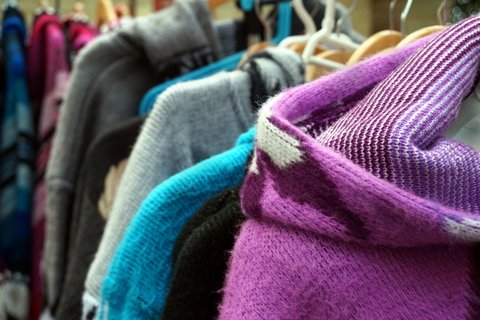-300x192-cropped.jpg)
Spandex fibre market expected to reach US$ 10,482 million by 2022
Growing apparel industry is one of the major factors driving the market.

12th August 2019
Knitting Industry
|
Slough
The report titled Latest Study on Knitted Fabric Market 2019-2025 contains market predictions related to market size, revenue, production, CAGR, consumption, gross margin, price, and other substantial factors. Growing apparel industry is one of the major factors driving the market. Furthermore, increasing importance of knitted fabric in the automobile, construction, manufacturing, and medical sectors is expected to fuel market demand over the forecast period.
Shifting consumer preference for lightweight and high-performance knitwear is fuelling the demand for feathery raw materials including polypropylene, linen, silk, faux fur, and synthetic fibres. Woven fabrics have been replacing bulked yarns made knitted fabrics. Over the past few years, the apparel industry has been witnessing steady growth in demand for the loop stitch jackets, cardigans, large shawls, and scarfs.
Furthermore, demand for feather light circular knit fabrics has increased in the hosiery market due to its better breathability of the material. Lightweight knitted textile has also gained significant traction in the protective clothes market. Sponge-like, anti-tear, and durable materials are applied in single or double layers in the protective clothes. Similarly, featherweight textile, along with high compression, chlorine resistant, and moisture management property, has witnessed high demand in the sportswear industry.
In addition, application of knitted fabric has been increasing in denim garments, as consumer preference is shifting towards wrinkle resistant, flexible, soft, and comfortable textile. Rising importance of synthetic fibres in the construction and apparel industries is expected to propel the growth of the market in the upcoming years. Application of the fibre has been expanding in the construction industry as geotextiles in roof, walls, dams, and roads.
Moreover, thermal insulation and dust resistant features of synthetic fibre make it ideal for the production of curtains, napkins, carpets, and table clothes. Implementation of artificial intelligence (AI) has been increasing in this industry.
"Fast adoption of 3D knitting machines in the industry has increased the productivity of the manufacturers. This machine can knit multiple yarns at the same time by using digitally stored information. This technology makes customization easier and saves both operating time and costs. These technological developments are expected to foster market growth over the world. However, rising cotton price and counterfeit products can hamper the growth of the industry in the near future," the publisher said.
Weft-knit fabric dominated the industry with a share of more than 60.0% in 2018. Low cost, better elasticity, and simpler production process make it more preferable among the manufacturers. It includes different types of stitches such as plain or jersey, rib, purl, interlock, double knit, and circular knitting. Weft knitting is commonly used for underwear, pyjamas, jumpers, scarves, hats, and gloves. Over the past few years, circular knitting machines have gained significant importance in the seamless hosieries and underwear manufacturing industry.
The warp-knit products are expected to witness the fastest CAGR of 6.4% from 2019 to 2025. Warp knitting is used in several industries including apparel, inner wears, shoes, household, automotive, and industrial. Rapid growth of the automotive, construction, and manufacturing industries is expected to fuel the segment growth. Different types of warp knitting include tricot knits, raschel knit, crochet knit, and Milanese knit.
"As of 2018, the technical application segment held the largest share of over 80.0%. Packaging, automotive, manufacturing, household, construction, and medical are the major applications in the technology sector. The raschel and crocheting knitting technology ensures safe and scratches free handling of sensitive components due to its knots free property. Therefore, it gained significant popularity in the packaging industry," the publisher adds.
One of the major applications of the product also lies in the automotive industry. The spacer fabric is widely used in the production of car seats, airbags, protective lining over wires, and roof due to its cushioning feature.
Knitted fabric has a wide application as home textiles in the household sector, including products such as home cushion, curtains, carpets, dust bags, dust covers, and door mattress. Synthetic material is gaining popularity in curtain manufacturing due to its light resistance property.
The product has gained significant importance in the medical textile. It has a wide application in the production of bandage, plasters, hospital laundry bags, wheelchairs covers and seating, medical mattresses, and orthopaedic support by using the 3D spacer, 4D spacer, meshes, plain, and brushed fabrics.
As of 2018, Asia Pacific dominated the knitted fabric market and accounted for 70.2% share of the total revenue. China holds the largest share among all the countries in the world. This nation is one of the top exporters of the clothing industry across the world. It represents one-third textile and apparel import of Europe. Manufacturers in this country are shifting towards automation and digitalisation for high high-quality knitting textile.
Other than China, India and Bangladesh are also prominent markets for knitwear.
Accprding to the publisher of the report, key players of this industry include Baltex; Jong Stit; Georg and Otto Friedrich; Zhejiang Chaoda Warp Knitting; Abhinandan Knits; Haining Jinmao Warp Knitting; Guilford; Loyal Textile Mills; Toray Industries; Pacific Textiles; Teejay Lanka; and SSM Industries. It is a highly fragmented market, which includes a large number of small producers and a few large producers.
However, the large players hold a significant share in the market. Over the past few years, manufactures of this industry are focusing on product development to widen the application sector. For instance, a UK based company Baltex has been focusing on the innovation of Advanced Surface Technology (AST), especially on 3XD spacer fabrics. Furthermore, the company is developing sustainable fabrics by using biopolymers.

Business intelligence for the fibre, textiles and apparel industries: technologies, innovations, markets, investments, trade policy, sourcing, strategy...
Find out more